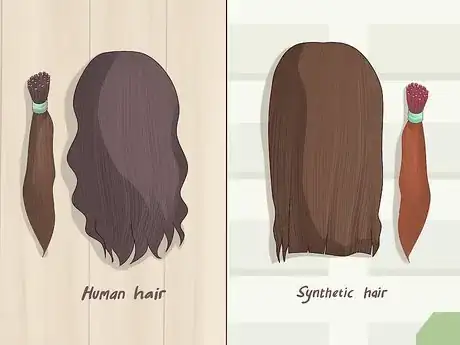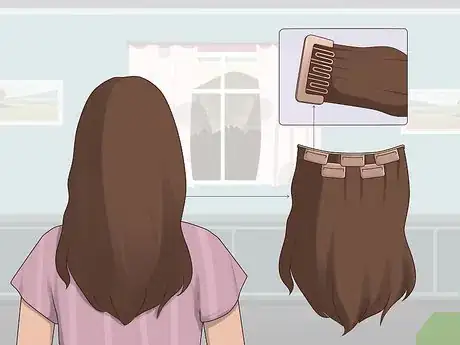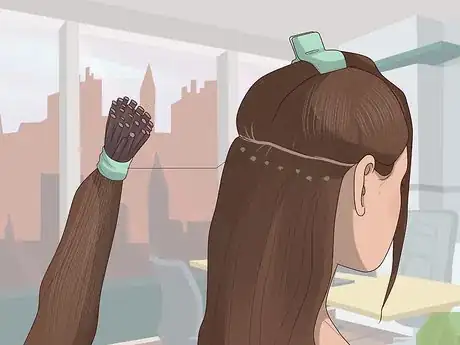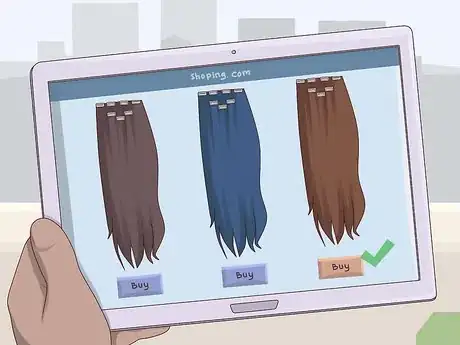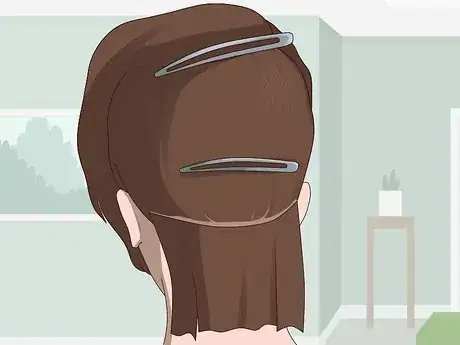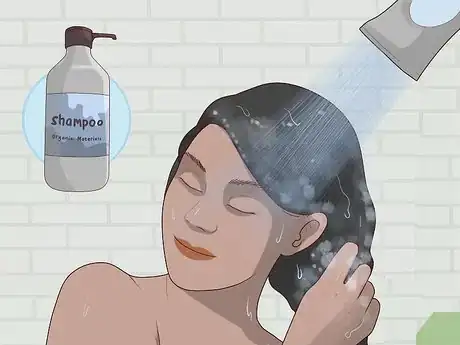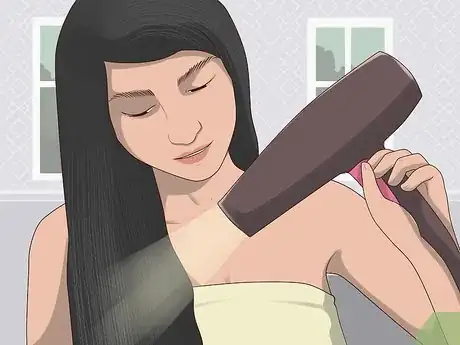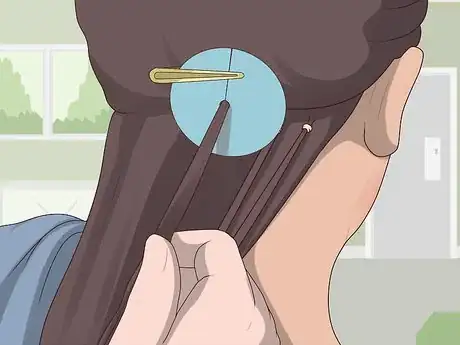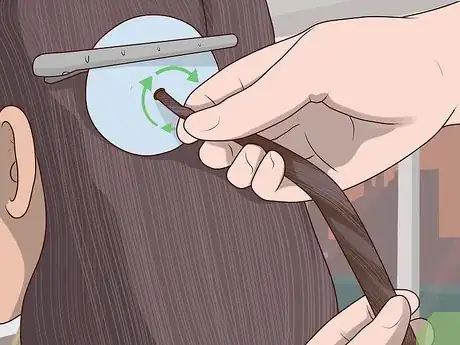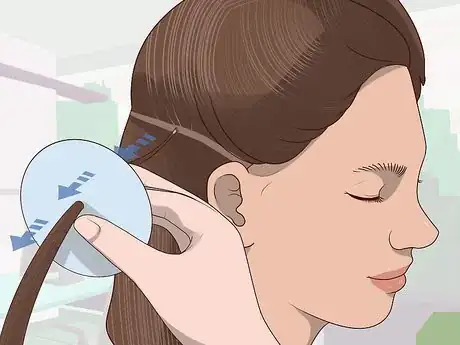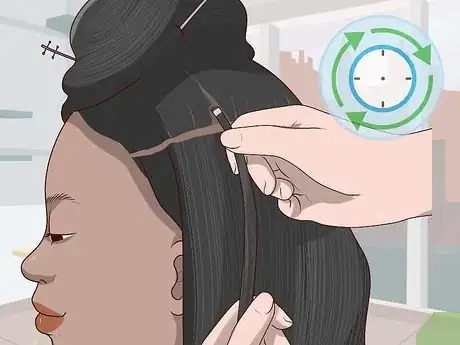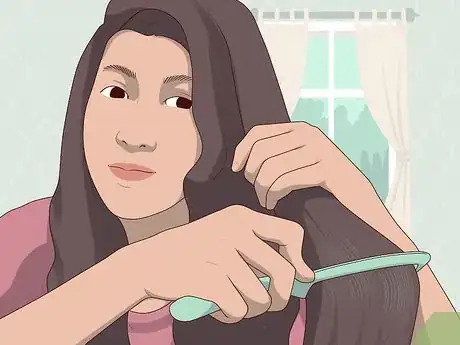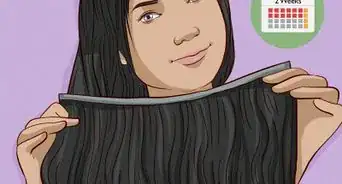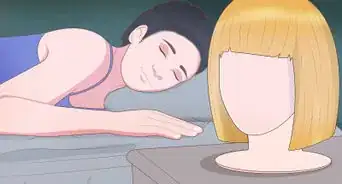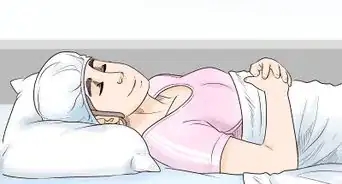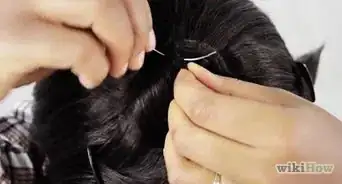This article was co-authored by Madeleine Johnson. Madeleine Johnson is a Hair Stylist and Hair Extensions Specialist based in Beverly Hills, California. She is affiliated with Hair by Violet Salon in Beverly Hills. Madeleine has over six years of hairstyling experience as a licensed cosmetologist. She specializes in microbead extensions and tape-in extensions. She trained under celebrity extension artist Violet Teriti (Chaviv Hair) and earned her cosmetology license from Santa Monica College.
This article has been viewed 402,739 times.
Want luscious long locks, but don't have the time or patience to wait around for them to grow? Then look into trying extensions! Hair extensions are natural looking, but they can take a while to apply.
Steps
Choosing Your Extensions
-
1Decide on the kind of hair you want. Hair extensions come in two different makes: synthetic or human. Synthetic extensions are a man-made keratin/plastic mix that mimics the appearance of human hair. Human hair is donated by real people and repurposed into extensions. Human hair extensions also come in many grades, such as Brazilian, Indian, Malaysian, three of the most popular. All of the best grade and textures of human hair come in its most natural state, this allowing for straighten, curling and even coloring to a desired color level. natural Brazilian, Indian and Malaysian hair installs will have different grades of textures, such as wave (a natural c formation throughout the weft), natural curl, (somewhat straight with natural body and fullness towards the ends and tight curl (the weft has a natural very tight ringlets ). When choosing human hair installs it is always best to use hair that is closest to your own natural texture, this will allow for smooth blending when installing your extensions.
- Synthetic extensions do a very good job of mimicking the appearance of human hair, but lack some of the texture that natural hair maintains. At the same time, synthetic extensions tend to be shinier than natural human hair.
- Human hair is much more expensive than synthetic hair, but it is also more versatile and natural looking. Unlike synthetic extensions, it can be styled with heat tools, chemically treated, colored, and washed and styled.
-
2Think about clip-in hair extensions. These are either synthetic or human hair that are attached to a hair clip at the base which allow for temporary extensions to your hair. These are a great option if you only want extensions for a particular event or day.
- These are the cheapest available hair extensions, and are also the easiest to install. They take only minutes to put in.
- Clip-in extensions must be reapplied on a daily basis as they begin to fall out over the course of a day. They are not very comfortable to sleep in.
Advertisement -
3Consider fusion hair extensions. Fusion extensions are synthetic or human hair that is treated at one end with either a special glue or keratin wax that is melted into your natural hair.
- Fusion extensions are the longest lasting extensions, but are also significantly more expensive than clip-ins.
- Although fusion extensions use heat, they are not too damaging to your natural hair. If you are afraid of damage, look into cold fusion extensions.
- Because of the difficulty in applying fusion extensions yourself, for the best results have a friend or stylist apply them for you.
Applying Clip-in Hair Extensions
-
1Purchase wefts of hair that match your hair color. A weft of hair is a single row of hair to be clipped between your own layers of hair to add length. You can buy either synthetic or human hair in wefts, with the latter being the pricier of the two options.
- Match your color as best as possible. Hair extensions are intended to look natural, which they are unable to do if there is a simple discrepancy in hair color.
- Find the right length of hair. Although you obviously want your extensions to be longer than your current length, avoid adding a dramatic amount of difference between your natural length and the extensions. Not only will it obviously look fake, but it will cost a significantly higher amount of money. Stick to 4 inches (10.2 cm) of extra length at the most.
-
2Divide your hair into sections. You can do this by pulling all of the hair on the top of your head into a ponytail. Leave a thin section of hair down against your neck/back. As you add extensions, you will continue to let down more sections of hair of about an inch each.[1]
-
3Tease your hair. Take a back-comb and rat your hair at the roots. You want your hair to gain ½ to a full inch in volume at the base of the strands.
- Teasing your hair gives the extensions something to stick to. Natural hair is too slippery for the clips to hold long without sliding down your strands.
- Ratting the roots of your hair also provides coverage for the clips. This makes it more difficult to tell you are wearing extensions.
-
4Take one weft and clip to to your hair at the roots. You should be able to dig into the teased section of hair to allow for the best stick.
- Be sure to evenly space the extensions, so that you have a level length of hair all the way around your head.
- You can give your hair the look of layers. Apply the extensions in evenly spaced vertical sections. You may need to cut the extensions to blend them in with your natural hair.
- Feel free to cut or trim your extensions to match the rest of your hair. You are not required to leave them as-is from the packaging.
-
5Remove another section of hair from your ponytail. Repeat the same steps as above, by teasing your hair at the roots and adding in one weft at a time.
-
6Finish your hair style. Tease your hair at the roots and brush out the top layer so that it is smooth. Your clip-in extensions should be completely blended so that you cannot see them at the roots of your locks.
- If you can see the clip from your extensions, rearrange them so that they are not visible.
- Be sure that your extension clips cannot be seen even if you put your hair in a ponytail. They should be close enough to the roots and blended with enough layers that they are invisible to the naked eye.[2]
Applying Fusion Extensions
-
1Clarify your hair. There are many clarifying shampoos available for purchase that help to cleanse your locks of any buildup or residue that might prevent the extensions from sticking to your hair.
- Do not use conditioner or other hair products after clarifying your hair, as you will be adding in the things you just removed with your clarifying shampoo.
- If you are afraid of your clarifying shampoo stripping too much, look for ones that advertise sensitive skin and are made from organic materials instead of more chemicals.
-
2Dry your hair completely. If your hair is at all damp, the glue from the extensions will not be able to stick.
-
3Make a divider for your hair. A divider will section out small pieces of your hair to fuse the extensions to, as well as protect your scalp from getting burned. To do this, you will need a piece of cardstock about three inches in diameter.
- Cut the cardstock into a circle, around three inches wide. It doesn’t have to be perfectly shaped, but using the curved figure will work best.
- Cut a slit on one side of the circle to the center, like drawing the radius. At the center of the circle, make an enlarged hole one to two millimeters wide.
- Now, you will be able to slide small pieces of hair to the center of the cardstock circle, where the fusion extension can be safely attached at the root without burning your head.
-
4Section your hair beginning at the base. Part your hair around two inches from the nape of your neck, pinning everything above that mark to the top of your head.
-
5Put a strand of hair into your cardstock divider. Pick up small sections and pull them through the divider. A crochet hook can be very useful for this. This will be the first piece you fuse, and should be around the same size of the hair extension strand. If you need to, clip the divider into your hair with a bobby pin or hair clip.
-
6Attach one strand of the extension to your divided hair. Line up the end of the extension with the roots of your hair so that it begins as near to your scalp as is possible.
-
7Use a flat iron to fuse the extension. Hold the end of the extension and your hair by the roots in the flat iron for a few seconds. Remove the flat iron for a few seconds and repeat. Be careful not to burn your own hair in the process.
-
8Roll the fused strands into your natural hair. Using your fingertips on the still-warm hair, make a rolling motion to blend the extension with your natural hair. This will help to set the glue or melted keratin.
-
9Remove the hair divider. Take another section from the same row of hair and replace your cardstock divider on a new strand of hair. Just remember to be careful of the newly fused section.
-
10Repeat the steps of dividing and fusing hair. Layer extensions evenly over your head so that they appear the most natural. Continue this process until you have used all of your extensions.
-
11Style your hair. Use a brush that has no nibs or bulging ends on the tips of the bristles so that you do not pull out your newly fused extensions. There should be no problem following your basic style routine post-extensions as long as you are careful not to damage the base of the fusion.[3]
- Don't brush or comb your hair near the scalp.
- Too much tension can result in the extensions sliding or falling out.
-
12Care for the hair extensions. Brush your hair regularly, making sure that you avoid brushing too close to the scalp. When washing your extensions, use sulfate-free products, and do not condition the scalp. Leave-in conditioners can help you keep out tangles.[4]
- Use a very gentle touch. Do not rub, scrub, or tug at your hair.
- You will need to have the extensions redone every six to eight weeks, as they will start to slide out around this time.
Expert Q&A
Did you know you can get expert answers for this article?
Unlock expert answers by supporting wikiHow
-
QuestionHow long do hair extensions last in your hair?
 Laura MartinLaura Martin is a Licensed Cosmetologist in Georgia. She has been a hair stylist since 2007 and a cosmetology teacher since 2013.
Laura MartinLaura Martin is a Licensed Cosmetologist in Georgia. She has been a hair stylist since 2007 and a cosmetology teacher since 2013.
Licensed Cosmetologist
-
QuestionIs it possible to achieve an up-do style with clip in extensions?
 Laura MartinLaura Martin is a Licensed Cosmetologist in Georgia. She has been a hair stylist since 2007 and a cosmetology teacher since 2013.
Laura MartinLaura Martin is a Licensed Cosmetologist in Georgia. She has been a hair stylist since 2007 and a cosmetology teacher since 2013.
Licensed Cosmetologist
-
QuestionWhere can I get real hair extensions?
 Laura MartinLaura Martin is a Licensed Cosmetologist in Georgia. She has been a hair stylist since 2007 and a cosmetology teacher since 2013.
Laura MartinLaura Martin is a Licensed Cosmetologist in Georgia. She has been a hair stylist since 2007 and a cosmetology teacher since 2013.
Licensed Cosmetologist
References
- ↑ Madeleine Johnson. Hair Stylist & Hair Extensions Specialist. Expert Interview. 18 December 2019.
- ↑ Madeleine Johnson. Hair Stylist & Hair Extensions Specialist. Expert Interview. 18 December 2019.
- ↑ http://www.youtube.com/watch?v=IwSCSmpX4hU
- ↑ http://www.allure.com/story/how-to-care-for-hair-extension-in-the-summer
About This Article
Wearing hair extensions is a perfect way to have luscious locks without waiting for your hair to grow. Your easiest option is to buy clip-on wefts that are the same color as your natural hair. Then, attach the wefts to the roots of your hair, leaving a space between each one so the clips are concealed under your hair. Comb each section of hair before you clip the weft in place to give it more volume, which will improve the clip’s grip. Alternatively, you can apply fusion extensions. To do this, wash your hair with a clarifying shampoo to remove any residue, and dry it thoroughly. Then, you’ll need to divide your hair into small sections about the same size as each extension strand. When you’re ready to apply a strand, hold it as close to the roots of your hair as possible and fuse it in place with a flat iron. While the hair is still warm, use your fingers to roll the extension into your natural hair. For tips on how to style your hair extensions, keep reading!
